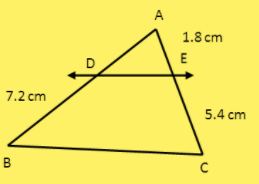
In $\vartriangle ABC$, $DE||BC$. Find $AD$ if $DB = 7.2cm$, $AE = 1.8cm$ and $EC = 5.4cm$.
Answer
578.1k+ views
Hint: Firstly, we will create the figure with the help of given data. Then, use the theorem of Basic Proportionality which states that:
If a line is drawn parallel to one side of the triangle to intersect the other two sides in distinct points, the other two sides are divided in the same ratio. We will put in all the values of the other 3 edges and get the required value.
Complete step-by-step answer:
Let us first create the figure of the given triangle with mention of side lengths $DB = 7.2cm$, $AE = 1.8cm$ and $EC = 5.4cm$ as follows:

Now, we also have the Basic Proportionality theorem which states that If a line is drawn parallel to one side of the triangle to intersect the other two sides in distinct points, the other two sides are divided in the same ratio. We will put in all the values of the other 3 edges and get the required value.
Now, in our triangle, we already have $DE||BC$ and $DE$ cuts $AB$ and $AC$ in distinct points.
So, we can apply the Basic Proportionality theorem here.
By using it, we will get:
$\dfrac{{AD}}{{DB}} = \dfrac{{AE}}{{EC}}$ ……(1)
(Because the sides are divided in same ratio)
Now, we already have the values: $DB = 7.2cm$, $AE = 1.8cm$ and $EC = 5.4cm$
Putting in all these values in (1):
$\dfrac{{AD}}{{7.2}} = \dfrac{{1.8}}{{5.4}}$
Taking 7.2 from denominator here to RHS, we will have:-
$AD = \dfrac{{1.8}}{{5.4}} \times 7.2$
Simplifying it, we get:
$AD = 2.4cm$
Hence, $AD = 2.4cm$.
Note: The student might make the mistake of applying this theorem anywhere, without checking the conditions, it requires. So, we must observe the conditions very carefully.
The student might make the mistake of not drawing the figure first, and directly writing the fraction, which may lead to the wrong answer due to the common mistake of imagining something else. So, we must always draw the figure first before trying to solve it.
We must remember the theorem “Basic Proportionality theorem” used in the solution of this question.
Fun Fact:- The “Basic Proportionality theorem” is also known as “Thales theorem” because a famous Greek Mathematician, Thales discovered the theorem.
If a line is drawn parallel to one side of the triangle to intersect the other two sides in distinct points, the other two sides are divided in the same ratio. We will put in all the values of the other 3 edges and get the required value.
Complete step-by-step answer:
Let us first create the figure of the given triangle with mention of side lengths $DB = 7.2cm$, $AE = 1.8cm$ and $EC = 5.4cm$ as follows:

Now, we also have the Basic Proportionality theorem which states that If a line is drawn parallel to one side of the triangle to intersect the other two sides in distinct points, the other two sides are divided in the same ratio. We will put in all the values of the other 3 edges and get the required value.
Now, in our triangle, we already have $DE||BC$ and $DE$ cuts $AB$ and $AC$ in distinct points.
So, we can apply the Basic Proportionality theorem here.
By using it, we will get:
$\dfrac{{AD}}{{DB}} = \dfrac{{AE}}{{EC}}$ ……(1)
(Because the sides are divided in same ratio)
Now, we already have the values: $DB = 7.2cm$, $AE = 1.8cm$ and $EC = 5.4cm$
Putting in all these values in (1):
$\dfrac{{AD}}{{7.2}} = \dfrac{{1.8}}{{5.4}}$
Taking 7.2 from denominator here to RHS, we will have:-
$AD = \dfrac{{1.8}}{{5.4}} \times 7.2$
Simplifying it, we get:
$AD = 2.4cm$
Hence, $AD = 2.4cm$.
Note: The student might make the mistake of applying this theorem anywhere, without checking the conditions, it requires. So, we must observe the conditions very carefully.
The student might make the mistake of not drawing the figure first, and directly writing the fraction, which may lead to the wrong answer due to the common mistake of imagining something else. So, we must always draw the figure first before trying to solve it.
We must remember the theorem “Basic Proportionality theorem” used in the solution of this question.
Fun Fact:- The “Basic Proportionality theorem” is also known as “Thales theorem” because a famous Greek Mathematician, Thales discovered the theorem.
Recently Updated Pages
Master Class 12 Business Studies: Engaging Questions & Answers for Success

Master Class 12 Economics: Engaging Questions & Answers for Success

Master Class 12 English: Engaging Questions & Answers for Success

Master Class 12 Maths: Engaging Questions & Answers for Success

Master Class 12 Social Science: Engaging Questions & Answers for Success

Master Class 12 Chemistry: Engaging Questions & Answers for Success

Trending doubts
Which places in India experience sunrise first and class 9 social science CBSE

Fill the blanks with the suitable prepositions 1 The class 9 english CBSE

Write the 6 fundamental rights of India and explain in detail

Difference Between Plant Cell and Animal Cell

What is pollution? How many types of pollution? Define it

What is the full form of pH?




